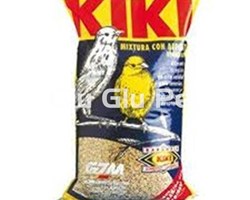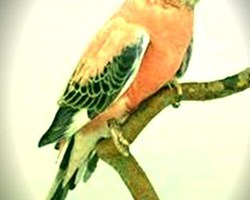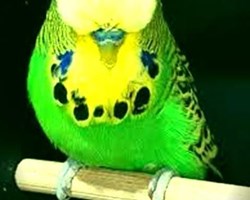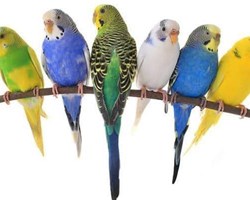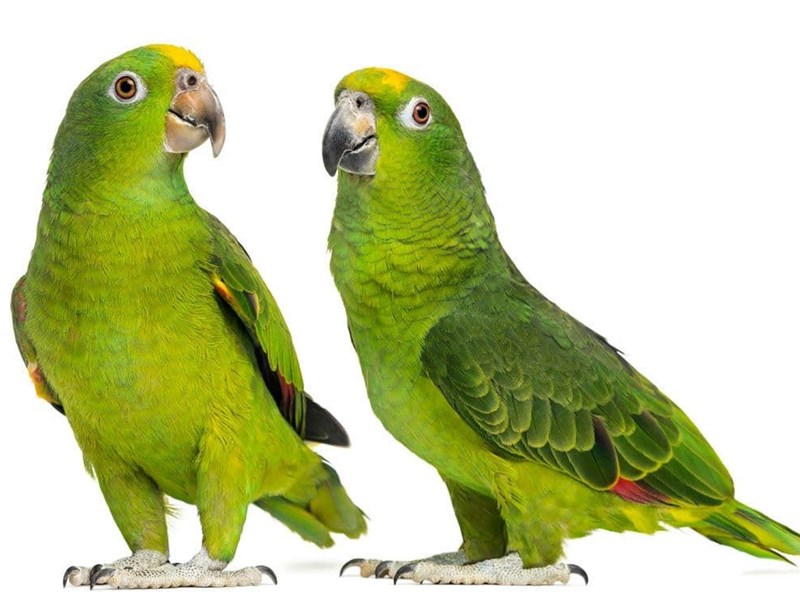
INDEX:
1.- ORIGIN AND HABITAT.
2.- DESCRIPTION.
3.- DISTRIBUTION.
4.- BEHAVIOR.
5.- CUSTOMS AND REPRODUCTION.
6.- FOOD.
7.- CARE.
8.- HEALTH OF YOUR AMAZON PARROT.
8.1.- MUTISM.
8.2.- SNEEZING.
8.3.- REGURGITATION MOVEMENTS.
8.4.- INSISTENT SCRATCHING.
8.5.- INACTIVITY (IT IS EMBOLATED).
8.6.- CHANGES IN THE FECES.
8.7.- OVERGROWTH OF THE BEAK AND/OR NAILS.
8.8.- TREMORS.
8.9.- CHANGES IN PLUMAGE.
8.10.- WHAT TO GIVE A SICK PARROT.
1.- ORIGIN AND HABITAT:
Amazon Parrot (Chrysotis amazonas)
Family: Psittacidae (Psittacidae)
Group: Psittaciformes
Origin: Latin America
Size: 35-38cm.
The origin of this parrot, also known as "Blue-fronted Parrot", is located in Latin America.
Its natural habitat extends from northern Argentina, Bolivia and Paraguay to Brazil.
It is an exotic bird that lives in wild areas such as humid jungles or palm forests forming groups with a leader.
At night they take refuge in the jungle and at dawn they go out to look for food in large flocks.
It is considered a monogamous species that usually forms a couple and lives within the community.
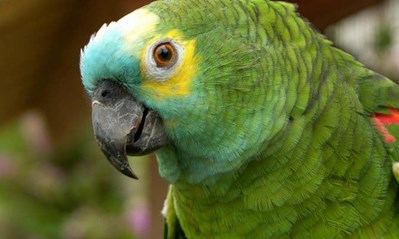
2.- DESCRIPTION:
The Amazon Parrot is a bird that:
MEASURES: between 35-38 cm.
WEIGHT: between 350-450 g.
SEXUAL DIMORPHISM: it is not clear, only an expert can determine the sex by looking at aspects such as the general size or that of the head and beak.
COLOR: Green is the predominant color of its plumage. The adult Amazon Parrot has more colors: green in the plumage, blue in the forehead and the bridles (modified feathers with the appearance of thick hairs that are found over the eyes and mouth), yellow in the throat, cheeks, crown and edge of the wings. at.
WINGS: The wings can also have a red edge and coverts.
LEGS: The bird with gray legs and a black beak.
EYES: The pups have dark gray pupils until they are a year old, when they are adults their eyes turn orange.
HEAD: When they are young they have different colors on the head (green, yellow, blue) and the edges of the wings are paler.
PLUMAGE: The plumage is basically green, with a red forehead, yellow cheeks (sometimes with red spots).
CROWN: The crown is blue and wide. They have blackish violet to bluish violet t-tail feathers towards the distal, with red patches on the outside of the secondary feathers. Adult males and females do not differ in plumage; chicks have less yellow on cheeks and less red on forehead.
BEAK: The beak is blackish.
LIFE: They are very long-lived birds, in which there have been extreme cases of animals that have survived to ages of 70 or 80 years.
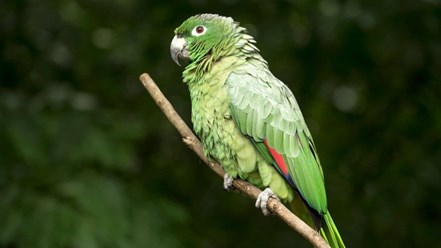
3.- DISTRIBUTION:
The Blue-fronted Amazon lives in primary and secondary forests, which does not prevent it from moving to more open areas in search of food.
In Bolivia, more specifically, in the Chaco region it inhabits both humid and deciduous forests and, in Paraguay, it has been observed in palm forests.
At dawn, large flocks of these birds leave the safety of the thick jungle, which they have used as protection during the night, and move in search of food.
During the flight in a flock, the pairs already formed can be observed and distinguished, since they fly together within the group.
4.- BEHAVIOUR:
It is one of the best known pet parrots for its ability to adapt to captivity and its ability to learn to speak.
Friendly in character, it gets along well with other members of the same species except during the breeding season, when the male becomes very aggressive with the others.
5.- CUSTOMS AND REPRODUCTION:
They are animals that reproduce relatively easily in captivity, but they need an aviary of correct dimensions, not in a cage.
The social character of the amazon disappears when it is in the breeding season, then they become solitary and very aggressive with their congeners, especially the male, who attacks anyone who approaches him.
Generally, the nests are installed in holes in the trees, at a high height, so it is safe from most predators such as snakes and various species of monkeys.
The main enemies of the Amazon, in its adulthood, are the birds of prey that inhabit the jungle.
The nest is lined inside with moss and plant debris.
The female lays two to five eggs that she will incubate for a period of approximately 25 days almost without interruption.
The male, during that time, will take care of feeding the female.
After the birth of the chicks, which are practically naked and very helpless, the male continues to bring food to the nest and the female offers it to the little ones.
During the first weeks, the food of the pups consists of a semi-digested porridge that, in addition to feeding them, provides them with ferments and vitamins that favor the proper assimilation of nutrients.
The young leave the nest at 8-9 weeks of age, at which time they are most vulnerable to their predators due to their inexperience and poor ability to fly since their wings are not exercised.
They will continue to be fed by their parents for some time to give their plumage and musculature time to develop properly and become independent.
The young will reach sexual maturity at the age of 5-6 years (in captivity they reach it a little earlier), although it is preferable that they reproduce when they are 6 years old.
In the first laying, the number of eggs, as well as their fertility, decreases below average. They usually breed once a season, with May being the most favorable period of the year for nesting in temperate climate zones and April in warm climate zones.
It is one of the best imitators that exist within the group of psittacines after the yacos.
They have a fairly developed learning capacity, especially in young individuals.
As they grow older, their learning ability decreases markedly.
Parrot toys help keep your mind awake and exercise it regularly, find a wide variety to choose your ideal toy at Glu Glu Pet.
Apart from being great imitators, they have another quality that characterizes them: a very powerful and sharp voice and they love to shout.
6.- FOOD:
They are animals that feed mainly on seeds, fruits and vegetables.
They adapt quite well to any type of diet or its variation without excessive problems.
At Glu Glu Pet you will find high quality specific feed for your Amazon Parrot.
The parrot must follow a varied and balanced diet.
Their main food is seeds.
Try giving him sunflower seeds, canary seed, white millet or on the cob.
You will also love hemp, peanuts or pine nuts.
In the main diet should not be lacking fresh vegetables and fruits, shoots and edible flowers or berries.
An extra supply of minerals with a mineral or calcium block with a food supplement will help you maintain optimal levels.
The specific feed contains the nutrients that your parrot needs.
As he is a big eater, you can give him a sporadic whim like toast or rib bone.
7.- CARE:
The decision to adopt an Amazon Parrot cannot be taken lightly, as these popular pets can live for more than 60 years, some cases have even reached their 90th birthday.
The Amazon Parrot is perhaps the best known of all parrots.
On his side, the extroverted and friendly character of these nice pets has made him get the popularity that they enjoy today.
The most famous parrot is capable of quickly adapting to life in captivity, and can also live without problems with other specimens of the same species.
We must provide him with a cage that is suitable for his needs and as large as possible, but we must not neglect facilitating regular trips around the house, always controlled, in order to evaluate the behavior and sociability of our exotic Amazon bird.
These parrots are tough and, as we have already said, they adapt and adapt well to different situations.
However, we must take care that during the winter they have a temperature of at least 14 degrees Celsius in order to preserve their health.
In turn, in Glu Glu Pet we can find special toys for parrots, so they will be entertained and calm their nerves a bit.
The diet of the Amazon parrot is very varied, and it will accept practically anything, although it is logical that its basic diet should be a compound food designed and thought to meet the needs of these exotic friends.
The ideal habitat for your parrot is an aviary, although they can also be housed in long cages as long as they have the minimum recommended dimensions so that it can move without problems and fully extend its wings without its tail touching the ground when it is supported by the innkeeper. (minimum 3m x 3m).
The space must be well ventilated and at a suitable temperature (minimum 12º in winter), the environment must be humid and cool.
The parrot needs to receive sunlight as long as it is not very strong.
The cabin will have two perches at different heights so that the bird can jump from one to the other, its diameter being similar to the thickness of its legs.
You must have a feeder, a drinker and a separate space so that you can bathe that will not be placed under the perches so that the parrot does not dirty them with excrement.
It is very important to keep his cage clean, removing waste daily, monthly disinfecting the cabin with bleach.
8.- HEALTH OF YOUR AMAZON PARROT:
8.1.- MUTISM:
As we already know, parrots are very talkative, boisterous and noisy animals.
If a parrot has stopped talking it may simply be because something has scared it and it needs to pay attention to the environment.
But if you permanently stop talking for more than a day, something is wrong.
It can be both physical and psychological, an illness, discomfort, changes in the home, etc.
8.2.- SNEEZES:
A parrot may sneeze occasionally to clear its nostrils of small particles floating in the environment, but if the sneezing continues, it is no longer normal.
An excess of dust accumulation in the air, tobacco smoke, the air fresheners that we use at home, can bother and damage the health of our parrot.
However, it may also be that the parrot has a cold, due to a viral or bacterial condition.
In addition, you may have air sac mites, tumors, or nutritional deficiencies.
8.3.- REGURGITATION MOVEMENTS:
The aforementioned head movements can also be accompanied by attempted regurgitation and can be one of the symptoms that a parrot is sick.
It could be that something is blocking his airway or his crop.
In many cases it is due to the presence of parasites or infections.
Remember to deworm your parrot regularly.
8.4.- INSISTENT SCRATCHING.
Skin problems, such as dermatitis, are common, although it can also be due to the presence of external parasites.
Stress and boredom can cause our parrot to develop abnormal behaviors such as stereotypes or even deleterious behavior, such as self-mutilation, which can start with a simple repetitive scratching.
8.5.- INACTIVITY (EMBOLATES):
Continuing with the symptoms that a parrot is sick, we already know that parrots are very active, curious and playful animals, so if a parrot does not want to eat and is sad or depressed, it is emboldened, does not want to move and even falls of the stick where it usually stays, it is very possible that we are facing a serious case that requires urgent veterinary attention.
He may have been developing a disease of nature whatever and hid it until he got to that point.
8.6.- CHANGES IN THE FECES:
Feces are a good indicator of the health of our parrot.
We must be vigilant if changes in color, consistency and frequency occur.
If it increases its frequency and the consistency is more liquid, the parrot suffers from diarrhoea.
These can be caused by an intestinal infection, parasites, chlamydia, lead or zinc poisoning, or liver problems.
If the color changes and the stools turn black, it may be because the parrot suffers from anorexia or has digested blood.
If they turn clear, the parrot may have a pancreas problem and if they are red, it may have blood in the final part of the digestive tract.
The color of the stool also changes depending on the type of fresh vegetable or fruit that we give it. For example, if we give him blackberries, the stool will be black and we should not worry.
8.7.- OVERGROWTH OF THE BEAK AND/OR NAILS:
The beak and nails of a parrot grow continuously, if we do not provide them with perches or toys that help them wear them down, they may have overgrowth.
This is one of the symptoms that a parrot is sick and can be associated with hormonal problems, tumors, nutrient malabsorption and other pathologies.
All this can cause an exaggerated growth of these parts of the body.
8.8.- TREMORS:
Tremors are part of the set of natural behaviors of a parrot, although they should not always occur.
For example, if an Amazon parrot trembles, it may be in its breeding season or it may have become nervous for some reason, such as that you are going to give it a toy or food that it loves.
But it could also be that he is very scared about something that is happening.
8.9.- CHANGES IN PLUMAGE:
The state of the plumage is indicative of the health, not only of a parrot, but of all birds.
Some of the negative changes that we can observe in the plumage and that are part of the symptoms that a parrot is sick are:
- Plucking: Parrots only shed their feathers once a year, so if your parrot continually sheds its feathers, something is wrong.
- Little brightness: if the plumage is dull, it may be that we are not giving it the right food or that it suffers from parasites.
- Bald spots: Bald spots can appear naturally or because the parrot is pulling out its feathers, which is known as "pecking", indicating that the parrot's stress levels are excessively high.
- Feathers in poor condition: if the feathers begin to grow, but are fragile, break, do not have the normal color or are deformed, our parrot could be suffering from a nutrient deficiency, stress or even have a genetic problem.
8.10.- WHAT TO GIVE A SICK PARROT:
In any of the situations mentioned throughout the article, the first thing we should do is go to a veterinarian specialized in exotic animals.
This detail is important, because parrots do not present the same pathologies as dogs or cats, nor do they require the same management.
We should not medicate the parrot without knowing what is happening to him, even if we have previously gone to the veterinarian and he has prescribed some medication, we will not give it to him until he recognizes it again in consultation.
The symptoms could be the same as before but the disease could be different.
Of the parrots, the most known about are the red-tailed African gray.
If you think your gray parrot is sick, see a professional as soon as possible.
Amazon diseases have been the most studied in science and their application is common to other parrots, or many of them.
We invite you to take your pet to the veterinarian in the event that it presents any type of condition or discomfort.

